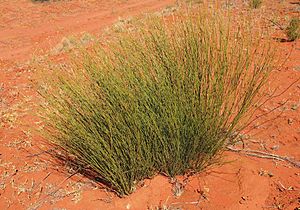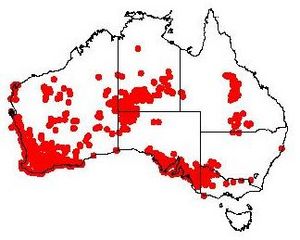Exocarpos sparteus facts for kids
Quick facts for kids Exocarpos sparteus |
|
|---|---|
 |
|
| Scientific classification | |
| Genus: |
Exocarpos
|
| Species: |
sparteus
|
 |
|
| Occurrence data from AVH | |
Exocarpos sparteus is a special Australian plant, often called the broom ballart, slender cherry, or native cherry. It's found only in Australia, across all the mainland states.
Contents
What Does It Look Like?
The broom ballart is a shrub that can grow up to four metres (about 13 feet) tall. It stands upright and has branches that droop downwards, making it look almost like it doesn't have many leaves.
Its flowering branches might have tiny, greenish-yellow leaves that don't have stalks. The flowers are very small, only about 1 mm wide, and are usually greenish-yellow, sometimes white. The fruit of this plant is shaped like an egg, is pink or red, and measures about 4 to 5 mm long.
This plant grows in an upright way, but its many branches curve slightly, giving it a rounded shape. The smooth, round look comes from its drooping branches, and how its leaves and flowers are similar in colour and size.
How Did It Get Its Name?
The scientific name sparteus comes from the Latin word esparto. This word refers to a type of Spanish grass that was used to make strong fibres.
The plant was first described in 1810 by a botanist named Robert Brown. He collected these plants when he visited King George Sound in 1802. One of its common names, "native cherry," is also used for a similar plant, Exocarpos cupressiformis, which has fruit that people can eat. Both of these plants are known as types of Ballart.
The Noongar people, who are Indigenous Australians, call this plant Chukk, Dtulya, or Merrin.
Where Does It Live and What Does It Do?
The fruit of the broom ballart is eaten by birds like the Australian ringneck (Barnardius zonarius). Other birds probably eat it too. People in Australia also used to eat fruit from Exocarpos plants, especially before European settlement.
This plant is a special kind of "hemi-parasite." This means it gets some of its food and nutrients by connecting to the roots of other plants. Many plants in the Santalaceae family, which the broom ballart belongs to, do this.
See also
 In Spanish: Exocarpos sparteus para niños
In Spanish: Exocarpos sparteus para niños

